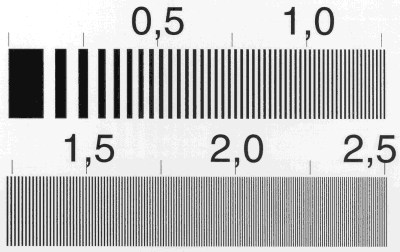Resolution (photography)

As a resolution or resolving power in is called photography the ability of a lens , film or sensor , certain small structures to be able to play.
detection
theory
To determine the resolution, test recordings of line patterns are made, which are usually black and white or at least one color. For this purpose, a film is exposed with a line grid that has an ever decreasing distance (increasing spatial frequency ). A microdensitometer is used to measure how strong the distinctions are between the increasingly narrow lines.
The image resolution is determined by counting the still recognizable number of line intervals per millimeter. The determined value is also called the modulation transfer function. Only values relating to light-dark contrasts are supplied. Therefore it cannot be deduced from this how good the resolution of multicolored structures is. For this it is necessary to use multicolored templates, such as white light interferograms or colored noise patterns .
practice
A distinction can still be perceived in the line grid, even if this distinction is fuzzy or has interference.

For this reason, a tolerance limit is set for every measurement method. This defines the number of tolerable deviations (blurring, interference, contrast, ...).
Basic problem
- There are no binding standards for defining tolerable deviations (blurring, interference, contrast, etc.) when determining the resolution. Therefore, tests never produce identical test results.
- There is no suitable method for comparing materials with different basic structures (film and sensor). On the one hand, structural effects (for example moiré ) are not taken into account; on the other hand, the test result depends largely on the tolerance definition. An example:
- Visibility of disturbances (grain): That would make the film the loser.
- High contrast at the edge border: That would make the film the winner.
Analog resolving power
Selected color negative and reversal films:
- The graininess is reported as an RMS value .
- The resolving power was measured at various object contrasts (1.6: 1 and 1000: 1) and is given in lines per millimeter.
| Film type | Graininess ( RMS ) | Resolving power in L / mm with object contrast | |
|---|---|---|---|
| 1.6: 1 | 1000: 1 | ||
| Color reversal films | |||
| Fujichrome Velvia 100 F (100 ASA) | 8th | 80 | 160 |
| Fujichrome Astia 100 F (100 ASA) | 7th | 60 | 140 |
| Agfachrome RSX II 100 | 10 | 50 | 125 |
| Ektachrome 100 prof. | 11 | 50 | 100 |
| Color negative films | |||
| Kodak Royal 25 | 80 | 200 | |
| Fujicolor Reala 100 | 4th | 63 | 125 |
| Kodak Ektapress Gold prof. 1600 | 11 | 40 | 80 |
| Black and white negative films | |||
| Copex gigabit film 25 | 4th | 90 | 900 |
| Kodak TMAX 100 | 8th | 63 | 200 |
Digital resolution
The resolution of digital camera sensors is also given in line pairs per millimeter. Since this resolution ultimately depends not only on the camera sensor, but also on the lens used, as is the case with film, this only results in reference values. At the beginning of digital photography, the number of pixels was also used for orientation about the resolution. This number is usually given in megapixels . The resolution actually achieved by the camera depends not only on the number of pixels, but also on the size of the image sensor and the hardware and software used by the camera to process the image signals. A measurement of the actually physically existing resolution can only be determined using a differentiated measurement method . There is still no uniform standard for such measurement methods, so that there are sometimes strong fluctuations in the measurement results.
Among other things, it must be taken into account that structural effects ( e.g. moiré ) can change the measurement result.

Without taking structural effects into account , the resolution cannot be clearly determined.
See also
- Sharpness
- Resolution (physics)
- Image resolutions in digital photography (table of common image resolutions in digital photography, sorted by aspect ratio)
Individual evidence
- ↑ Information according to the manufacturer's data sheets and typical comparison values at scandig.info
